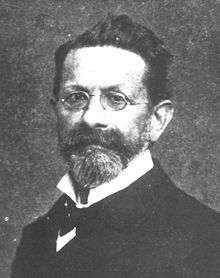Karl Alfred Ritter von Zittel

Karl Alfred Ritter von Zittel (25 September 1839 – 5 January 1904) was a German palaeontologist.
Biography
He was born at Bahlingen in the Grand Duchy of Baden, and educated at Heidelberg, Paris and Vienna. For a short period he served on the Geological Survey of Austria, and as assistant in the mineralogical museum at Vienna. In 1863 he became teacher of geology and mineralogy in the polytechnic at Karlsruhe, and three years later he succeeded Oppel as professor of palaeontology in the University of Munich, with the charge of the state collection of fossils.
In 1880 he was appointed to the geological professorship, and eventually to the directorship of the natural history museum of Munich. His earlier work comprised a monograph on the Cretaceous bivalve mollusca of Gosau (1863–66); and an essay on the Tithonian stage (1870), regarded as equivalent to the Purbeck and Wealden formations.

In 1873-74 he accompanied the Friedrich Rohlf's expedition to the Libyan Desert, the primary results of which were published in Über den geologischen Bau der libyschen Wuste (1880), and further details in the Palaeontographica (1883). Dr Zittel was distinguished for his palaeontological researches. From 1869 until the close of his life he was chief editor of the Palaeontographica (founded in 1846 by W Dunker and H von Meyer).
In 1876 he commenced the publication of his great work, Handbuch der Palaeontologie, which was completed in 1893 in five volumes, the fifth volume on palaeobotany being prepared by WP Schimper and A Schenk. To make his work as trustworthy as possible Dr Zittel made special studies of each great group, commencing with the fossil sponges, on which he published a monograph (1877–79). In 1895 he issued a summary of his larger work entitled Grundzuge der Palaeontologie (ed. 2, part i, Invertebrata, revised by Dr Zittel in 1903; the American edition of 1900 by Charles Rochester Eastman is so revised, sometimes in opposition to Zittel's views, as to be practically an independent work).
He was author of Aus der Urzeit (1873, ed. 2, 1875); and Die Sahara (1883). In 1899 he published Geschichte der Geologie und Palaeontologie bis Ende des 19 Jahrhunderts[1], a monumental history of the progress of geological science (Eng. trans., Mrs Maria M. Ogilvie-Gordon, 1901).[2] Dr Zittel was from 1899 president of the Royal Bavarian Academy of Sciences, and in 1894 he was awarded the Wollaston medal by the Geological Society of London.
Notes
- Regarding personal names: Ritter is a title, translated approximately as Sir (denoting a Knight), not a first or middle name. There is no equivalent female form.
- Zittel Cliffs in Antarctica are named after him
Notes
- ↑ von Zittel, Karl Alfred (1899). Geschichte der Geologie und Palaeontologie bis Ende des 19 Jahrhunderts (1 ed.). München und Leipzig: Oldenbourg. Retrieved 20 July 2017 – via Bayerische StaatsBibliothek digital.
- ↑ von Zittel, Karl Alfred (1901). History of Geology and Palaentotlogy to the End of the Nineteenth Century; Translated by Maria M. Ogilvie-Gordon (1 ed.). London and New York: Walter Scott and Charles Scribner's Sons. Retrieved 20 July 2017 – via Internet Archive.
References
| Wikimedia Commons has media related to Karl Alfred Ritter von Zittel. |
 This article incorporates text from a publication now in the public domain: Chisholm, Hugh, ed. (1911). "Zittel, Karl Alfred von". Encyclopædia Britannica (11th ed.). Cambridge University Press.
This article incorporates text from a publication now in the public domain: Chisholm, Hugh, ed. (1911). "Zittel, Karl Alfred von". Encyclopædia Britannica (11th ed.). Cambridge University Press.
External links
- Zittel, Karl Alfred von (1901) History of Geology and Palaeontology
- Zittel, Karl Alfred von (1900) Textbook on Paleontology volume 1
- Zittel, Karl Alfred von (1902) Textbook on Paleontology volume 2
- Works by or about Karl Alfred Ritter von Zittel in libraries (WorldCat catalog)